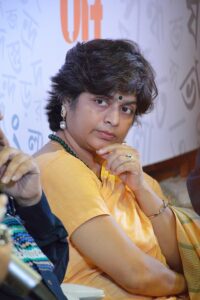TRANSLATED FROM THE BENGALI BY SUCHETONA PAL

Tilottama Majumdar
Tilottama Majumdar is a renowned novelist, essayist, short story writer and a poet who has largely written in Bengali. While she has been a recipient of numerous accolades for her critically acclaimed novels such as Basudhārā, (Ananda Puroshkar, 2003), Ektārā (Sreshtho Uponnyas Puroshkar Ebong Bhagolpurer Sarot Smriti Puroshkar, 2007) and Rajpat (Kakkanadan Foundation Sahithya Puraskaram, 2013), her short fictions produce sharp commentaries on the wide array of subjects most compellingly. As a writer, Tilottama Majumdar hardly offers any scope for pleasure reading. For someone who is unacquainted with her work, choosing her short-stories after a tiring day at work, with the hope of catching a break from the mundane reality would be a mistake. Her literary work in general demands undivided attention from the readers. Although enormously experimental with the themes and the use of literary devices, most of Majumdar’s short stories deviate from the prescribed norm of brevity as enumerated in the modernist short fictions. She treats the genre rather as a flexible form which is primarily dependent on the thematic urgency. If a story revolves around a specific character and the ramifications of his/her/their actions, it concludes only after the conflict is resolved. Majumdar’s short fictions therefore cannot be treated as fragmentary, slice-of-life or psychological sketches of the Chekhovian tradition. She presents her short story with a decisive ending that is complete in itself. Majumdar, in this regard belongs to the plot-oriented category of short story writing spearheaded by Guy de Maupassant.
Clarity in perception and boldness in presentation in terms of both theme and linguistic precision are the characteristic features of Majumdar’s short stories. Harbouring any assumption similar to a modernist short fiction, such as the evocation of any sense of ambiguity at the end of the text, or the readers’ crucial involvement in constituting the meaning of the text are partly immaterial to her short fictions. Rather it is Majumdar’s omniscient narrative voice which usually partakes in the process of analysis and re-analysis of the conflict it introduces in the course of the text. Consequently the reader is enabled to form his/her own impression through his participation, in the prolong discourse regarding the question of moral principles and ethical choice. Even though her stories are frequently charged with a sense of purpose, that aims to eradicate social evils by critiquing any regressive ideology and practice, yet they cannot be termed explicitly didactic. This is primarily because the authorial voice eloquently espouses a sharp satire against any existing form of oppression in the society. Her characters are shaped as much by their socio-political and socio-economic ideologies as by their complex psychological aspects. They are firmly rooted in the real world which is fraught with violence, poverty, exploitative economic system and unequal gender-norms. The characters come from a wide range of background- from the elite society of a comfortable and cosmopolitan status to the abysmal poverty of the homeless condition. Like the 19th century literary works of the naturalistic writers, the characters often appear to be the victim of the unfair laws and age-old customs in the society.
An estranged note of lyricality has often been used to delineate characters, which tend to produce an abstract effect beyond the realistic form of story-telling. The author succeeds in this art of dispassionate representation either through an allusive style of writing or by using few distinctly poetic metaphors. The unpalatable reality is meticulously portrayed, often with a thorough critical insight that borders on exaggeration. This style of writing effectively draws our attention to the artificiality and pretences of the corrupted socio-economic structure governing our life. The lyrical notes of the stories such as “Malakar” and “Sayan sayantani” are reminiscent of Tagore’s Lipika in their unusual amalgamation of poetic prose narrative. Thematically both appear to be similar, where two contradictory principles of the universe expressing a romantic impossible dream seek unification in their mortal embodiments. In a work like “Chnera Chnera Pata” the recurrent metaphor of a river indicates the protagonist’s desire to escape from her suffocating marital life. The protagonist’s repeated but frail attempt of communication is also conveyed through the imagery of a dinghy and her stubborn effort to compose coherent letters. The allusive style is noticeable in “Pari, Jakshini, Annapurnara” and “Shangsapatro” which refer to the concepts essentially embedded in the ancient Indian texts, such as Puranas.
Characters are often presented unnamed, typified either by their special attribute or by a kind. In a story like “Pora kath” the characters are named after their age group and gender. Therefore the characters are introduced as – a young man, a young woman and an elderly mature figure. The axis of the plot revolves around a simple yet cautionary dictum- that love must endure the ravages of time, even though it may lose its youthful vivacity. “Aw, Aa, Kw, khaw” although provides the names of the two characters, they symbolize the unique voice and independent capacity of thinking against the backdrop of homogenizing mass culture.
Often Majumdar’s philosophical approach to her theme presents a distinctively imaginative world. It may appear utopic, but nonetheless artfully conceals the destructive propensities of its own deformities. At the outset, stories like “Ichhechor”, “Britto” and “Amritobhavan” exhibit a fairy-tale like structure. Beyond the surface simplicity, the author offers a moral allegory against the folly of self-deception, condemning both immeasurable greed and selfishness. As a political satire, “Ichhechor” critically comments on the nature of monarchical rule, the ignorance and snobbishness of the King, as well as the ever-increasing appetite for imperial growth and expansion. A king, who wilfully loses sight of his noble obligation, and seeks his own pleasure foolishly, eventually becomes a victim of his own illusion. On the other hand, his subjects who never attempt to awaken their king from such distorted version of reality suffer terribly. The story may remind the readers of Kafka’s parables in its depiction of the detached monarchical figure, who is preoccupied in achieving only his own sense of happiness. Majumdar’s work however unlike Kafka emphasizes less on the profound spiritual meaning, but fulfils the expectations of a successful fairy-tale. It is interesting to note that the story has been originally written for a children’s magazine. The names of the characters such as “Alusita”, “Khusimoto”, “Khetekhawa” in the story “Britto” indicate the close resemblance with the genre of morality plays, where the characters are named according to their moral character-traits. The prolonged battle of Nekumoto and Sankomoto, over their sexual right on a beautiful woman, Alusita, may remind one of Trojan War centring Helena. In “Mimir Tanpura” however the realistically portrayed set of characters illustrates one significant moral lesson, that is – to exercise caution against avarice in the pursuit of art. The eponymous character is the symbol of both artistic creativity and Divinity, and the rest of the characters can be divided along the line of their ethical choices and righteous actions.
The necessity to voice discontentment against any form of injustice is boldly proclaimed in all of Majumdar’s text. However her criticism is most scathing in her rendering of the hypocrisy ingrained in the patriarchal society. Majumdar has revealed that a writer needs to resist any form of tyrannical oppression, and although she claims to have employed a gender-neutral voice, the victimized and exploited women characters repeatedly found most telling expression in her short stories. A recurrent theme in Majumdar’s work is the exploitation of women within the domestic space under the patriarchal institution like marriage. A number of stories depict how violence is coded in a marital relationship where invariably the woman occupies a powerless position. A story like “Asnan” explores not only the social stigma around divorce, but also analyses how the divorced woman is discouraged to exert her own choice despite achieving her financially independent status. Similarly, in the story “Devi Om” Majumdar’s satiric wit transforms the quasi-serious preamble to the significance of a Goddess, into the prevalent features of any ordinary married woman under the shadow of an influential husband. The powerful influence of the pair is established as they are explicitly compared to Lord Vishnu and Goddess Lakshmi through the obvious association with their respective names. The story not only examines the nature and extent of their dubious manoeuvre but underlines the subjugated status of a woman, vulnerable in the masculine world of power-struggle.
Motherhood as a theme evokes a multilayered and ambivalent response in a host of her stories– “Kukurchanar Ma”, “Palashknurira”, “Arijit o Arati”, “Alok -Akasher Ma”, “Maya” and “Ma Amar Ma”. Consequently Majumdar has not assigned any conventionally ideal role to the identity of a mother. For instance in “Palashknurira” the biological mother abandons her new-born baby in the street, to elope with her lover. While the other equally ill-equipped women may attempt to take up the responsibility of a mother, each of them is driven by their vested interest. On another instance like “Arijit O Arati”, it is the son who selflessly sacrifices to keep his mother safe and sane. Representation of hostility between the mother and the daughter also receives a unique treatment in stories like “Shubha o Oporahno”, “Ma o Meye”, and “Garvapatakini”. Here, Majumdar’s critical perception is undoubtedly entrenched in the complex psychological analysis and the gender expectations of a patriarchal society. The friendship blossoming between two women transcending the typical antagonism between women has recurred in stories like “Tan”, “Nanad-Boudir Rannaghar” and “Jyotirlina”. The sheer volume of stories centring on women which presents a criticism of their conventional roles, apart from highlighting the writer’s concern over appropriate representation of gender also exemplifies the possibility of the multivalent treatment of such themes.
There are several stories that depict miscellaneous topics crucial in the contemporary era– for instance, “Bikeler Alo” deals with the gradual encroachment of the playground for children in the era of rapid urbanization. “Putreshti” makes a commentary on the social schism still prevalent between the lower and the upper caste of the Indian society where a Santali student may receive scholarship for studies, but is bullied among his peer group. “Chobi” similarly brings out the wretchedness of an adolescent domestic maid who frantically hopes to be rescued by a television actor living nearby. “Panchtara” describes the innocent desire of a small town couple to spend a night in a five star hotel. Stories like “Amerudandi and “Gonna” both attempt to expose the corrupted socio-political milieu in a deeply satirical tone, that surpasses realistic depiction at times. While the former narrates the degrading cowardice of a reluctant ordinary man terrorized at the hands of the local ruffians, the latter revolts against every instance of debauchery and falsity existing in a society. Above all, Majumdar’s oeuvre demonstrates the necessity to analyse closely and repeatedly the status quo of the marginalized – in terms of economy, gender, caste and creed.
Italo Calvino mentions in “Whom Do We Write For? Or The Hypothetical Bookshelf” that a writer writes so that his books can be placed in a “hypothetical bookshelf” that collects vastly dissimilar books. He compares such diversity as one which “can produce electric shocks…”.Tilottama Majumdar’s anthology of short stories contains such shocking juxtaposition in terms of rich texture, resource and the multiplicity of thematic treatment.
Work Cited
- Calvino, Italo. “Whom Do We Write For? or The Hypothetical Bookshelf”. The Literature Machine. Trans. Patrick Creagh. London: Vintage Random House, 1987. Print.
- Majumder, Tilottama. Panchasti Golpo. Kolkata: Ananda Publishers Private Limited, 2012.Print.
- “On the Map 2017: Tilottama Majumder”,(IWP Residency: On the Map). YouTube, uploaded by International Writing Program. 5th June 2020. www.youtube.com.
Also, read a book review of Unbound written by Sanjukta Dasgupta, reviewed by S. Vincent and published in The Antonym:
Follow The Antonym’s Facebook page and Instagram account for more content and exciting updates.


























0 Comments